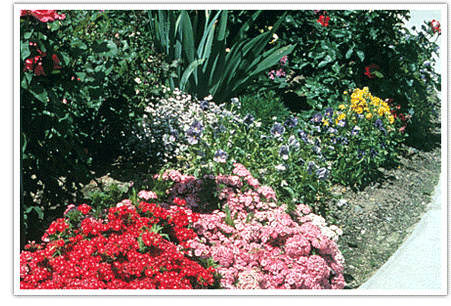Maintenance: New Plant Care
Return to Landscape Guide Main Page
How often should new plants be watered?
 Ask yourself the following questions to develop a feel for watering frequency:
Ask yourself the following questions to develop a feel for watering frequency:
- How long since transplanting? Newly planted plants require more frequent watering than established plants. Begin to cut back the frequency after two to three weeks as the plant roots start growing out into the surrounding soil and the above ground portion of the plant shows strong signs of new growth.
- How hot and windy is it? Heat and wind cause increased water loss by plants. When daytime temperatures move into the 80s, water newly transplanted plants every other day. Once the air temperature hits the 90-degree mark, check the plants morning and evening, looking for wilted leaves as an indicator of dryness. Initially, a daily watering will be needed for small plants.
- How deep did that last rain penetrate the soil? Rain amounts can be deceiving. Always stick a shovel into the ground after a rain and do a visual check as to how deeply the water soaked into the soil. The soil needs to be damp at least four inches deep to benefit new transplants.
- What pot size was the plant grown in? Small perennials and bedding plants transplanted from four-packs and four-inch pots will need more frequent irrigation than five-gallon sized plants. Do not water four-inch and five-gallon plants on the same schedule.
- Have the plants been mulched? Mulching plants can cut watering frequency by half (i.e. every other day vs. daily; twice weekly vs. every other day).
- What type of soil do you have? Compost enriched soils hold more water in the root zone than unprepared soils. Clay and loam-type soils hold more water than sandy soils. Sandy soils dry out very quickly and plants will need very frequent irrigation when first planted. Also, keep in mind that when climate conditions are very dry, extra water is needed to replace moisture lost to the dry soil surrounding the planting hole.
To minimize the frequency of watering, mulch thoroughly. Enrich the soil with compost. As a point of reference during hot, rainless periods, a healthy established annual or perennial plant should be watered one to three times a week. A woody tree or shrub under these same conditions would need a thorough soaking once or twice-weekly.
How much should the plants be watered?
Always construct an ample water saucer (well) around each plant and mulch. When it is time to water, fill the well twice allowing the water to be absorbed completely before filling it a second time. During the dry, hot months of the summer, conventional turf lawns and ground cover beds will need one inch of water every week. Native grass lawns and xeric ground covers need one inch every other week.
When you water, soak the soil thoroughly. It is preferable to water deeper and less frequently than to water lightly with much greater frequency. Deep watering promotes deep root growth.
What are the signs of over-watering?
When the soil stays wet and leaves of recent transplants become yellow and chlorinated looking, cut back the frequency of watering by half. For example, if you are watering every other day, cut back to once every fourth day.
If you are watering regularly but the leaves look wilted all the time, the plant roots are dying of suffocation. Too much water keeps the soil water-logged and oxygen deficient. Pull back the mulch from the plant and let the top inch of the soil dry between watering.
But these plants are supposed to be xeric
Xeric plants do not need much water once established but they do need careful attention to their watering needs during the first growing season. These plants have extensive root systems that pull water from the surrounding soil. Until a new transplant can re-establish its root system, it needs regular irrigation during rainless periods to grow and prosper.
When hand watering on a slope, water until the water is not being absorbed by the soil and begins to runoff. Stop, let the water soak in a few minutes and then start again. Repeat this process four or five times until the soil is wet to a depth of four or more inches. This technique will reduce the amount of runoff and slope erosion.

